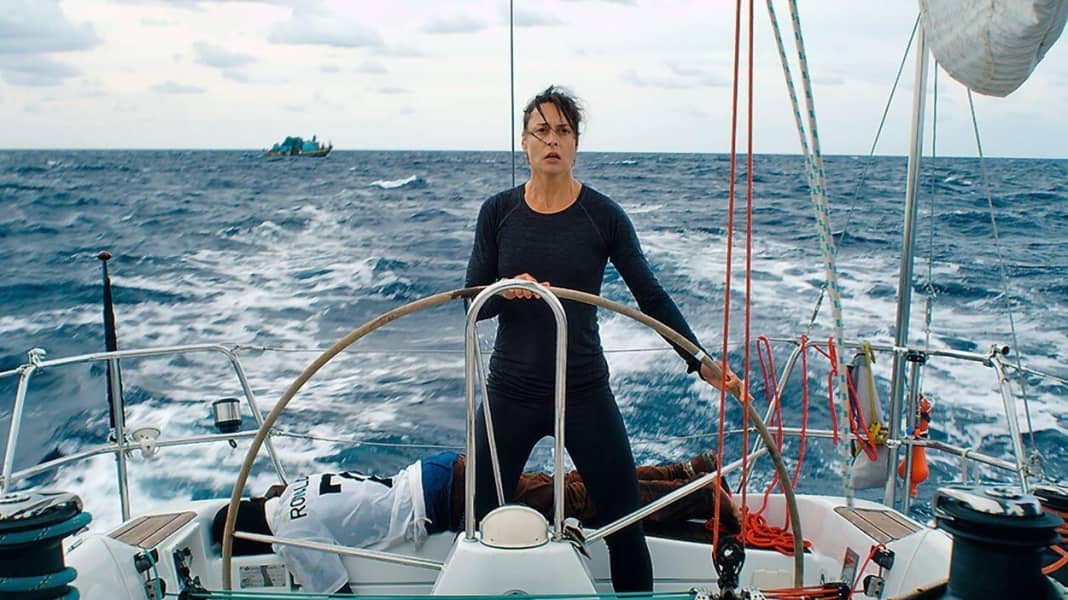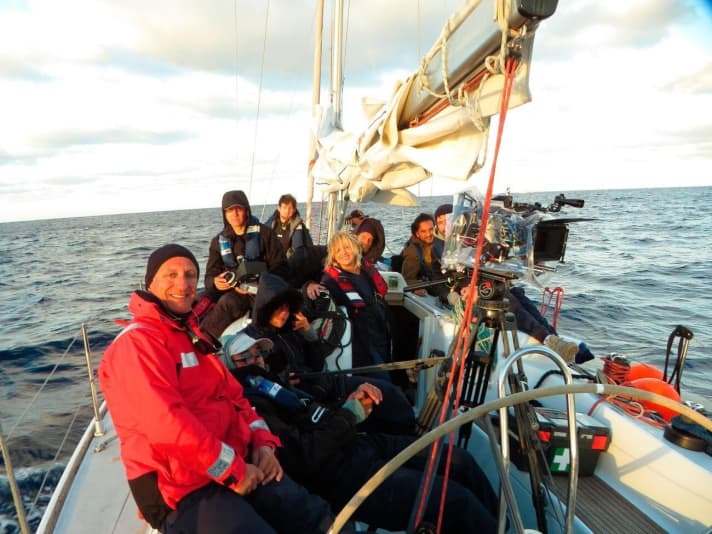
The drama "Styx" was honoured with a Silver Lola at the German Film Awards on Friday. In the film, a single-handed sailor encounters a refugee boat on the Atlantic. After it becomes clear that help from a third party is not coming any time soon, the skipper has to make a decision herself.
Susanne Wolff also won a Lola for best leading actress, and the awards for best sound design and best camera/image design also went to "Styx", the film by Marcos Kantis, written by Wolfgang Fischer and Ika Künzel and directed by Wolfgang Fischer.
The Lola is the most highly endowed award for German film, totalling almost three million euros.
Trailer "Styx"
Dream cruise turns into a drama - What the film is about
How do we act when we have to help? Austrian director Wolfgang Fischer raises this question in his feature film "Styx", which was released in German cinemas last September and is now listed in many online media libraries.
In the film, German emergency doctor Rike sets off on a single-handed voyage from Gibraltar to Ascension Island in the South Atlantic. It is supposed to be her break from work, a long-planned dream trip. But on the Atlantic, the sailor encounters an overloaded refugee boat that is in danger of sinking.

She informs the Spanish coastguard by radio and requests help. However, they are slow to arrive, but instruct the sailor not to do anything herself under any circumstances. As hour after hour passes and the doctor has to watch people jumping from the sinking ship into the water, she decides to take action.
One-woman show at sea
Emergency doctor Rike is played by German actress Susanne Wolff, who spent several days at sea with instructors before the start of filming in order to credibly embody the role of a single-handed ocean sailor. Wolff's sailing experience up to that point was based on a few trips with her father and dinghy trips.
In addition to her convincing portrayal of an offshore sailor, the big challenge for her was not to make the film seem monotonous, especially at the beginning - without any dialogue. However, at the latest when she encounters the refugee boat and makes radio contact with the authorities, "Styx" picks up speed and presents the skipper with a human dilemma in addition to the sailing challenge.
Interview on the film release
YACHT spoke to Wolfgang Fischer about his production on a highly topical and explosive subject: What can and must yacht sailors do when they encounter a boat with refugees in distress in the Mediterranean? And what challenges did they face when shooting the film on the high seas? Fischer produced the film almost exclusively on board a Grand Soleil 40, and almost all the scenes were actually shot at sea.
You can read the interview on the following page.
"How do we act when we have to help?"
In the cinema film "Styx", a single-handed sailor meets a refugee boat in distress - what to do? Director and screenwriter Wolfgang Fischer on a highly topical subject and the challenge of realising it on film
YACHT: Mr Fischer, in your film "Styx", a single-handed sailor sets off on a trip from Gibraltar to the island of Ascension in the Atlantic. Not exactly a typical route for a holiday cruise - why does your protagonist sail there of all places?
Wolfgang Fischer: When preparing this film, I asked many long-distance sailors what they found particularly impressive. Most of them said it was seeing green land again after three weeks on blue water. As the film is also about the search for individual paradise, the main character is determined to sail to this small, green Atlantic island during a time-out - her very personal place of longing.
But then things take a completely different turn and she finds herself in the middle of an emergency situation.
Exactly. The sailor is introduced in the film as a person who masters her job as an emergency doctor, can sail a yacht alone at sea and even survives a storm. But then she finds herself in a dilemma that is much worse than a storm could be. And she is forced to make existential decisions for herself out there.
This dilemma is the actual theme of your film: How do you as a sailor deal with the situation of encountering an overloaded refugee ship? How did you, as a non-sailor, come up with the idea for this question?
I had wanted to make a film about migration for a long time. The question was how to tell a very personal story about the problem from our western perspective. I spoke to sailors who had been in a similar situation in the Mediterranean. They said in unison that they didn't know what to do. One said that he had switched off his navigation lights and sailed away because the situation had simply overwhelmed him.
But you don't just want to appeal to sailors with the film, do you?
No, of course not. The special thing about the situation on the yacht is that the single-handed sailor has no other person to share her thoughts with and has to make all the decisions alone. But that can happen to anyone. So it's really a question of: How do we act when we suddenly have to help? What can we do and what do we not want to do? But it's not about apportioning blame and asking who the bad guy is. The topic is far too complex for that.
A large part of the dialogue takes place on the radio. How did you write them to make them as credible as possible?
In fact, the film team and I had to become professionals in many areas that we had absolutely no idea about, for example sparking and sailing itself. I had previously done a sailing trip from Norway to the Shetland Islands - I was fascinated by that, as well as the archaic marine world. I really wanted to make a film in this environment. But I didn't actually know how to sail and first completed a course on the Wannsee together with the cameraman and trained on small dinghies. On the subject of radio: we took advice from marines and professional sailors. How they radio, what terms they use and so on.
Is your leading actress Susanne Wolff also a sailor in her private life?
She actually has a sailing licence, and her father was a sailor and often took her sailing with him. But she had never sailed on an ocean before. So we had to practise a lot, we did training weeks in the Baltic Sea and off Malta, where we were filming, with a skipper so that she could get to know the boat. After all, we wanted to show her: This boat belongs to her, she knows it inside out. A professional skipper was also on board because of the insurance, but Susanne really did sail the yacht on her own during filming. That was important for the authenticity that runs through all areas: The firefighters are real firefighters and the soldiers are real soldiers. The aim was to make everything as realistic as possible and therefore to shoot as much as possible at sea.
Which was probably not always easy.
That's true. All my director colleagues advised me against it, simply because you can't control the sea. There was also the question: how do you film on a sailing boat?
And how does that work?
We had a 40-foot Grand Soleil, which we sailed almost continuously for 45 days with ten to twelve people, trying to shoot this film. Sometimes in 8 to 9 Beaufort - we had a schedule to keep. From a technical point of view, it was just as big a challenge as it was physically and mentally. Especially as there was nowhere for the crew and actors to retreat to, not even when they got seasick, which happened to about half the team.
How much of the film was made at sea?
Almost everything. We shot a lot between Malta and Sicily, but also a bit on the Atlantic, which is where the film is set. As a viewer, you should really have the feeling that you are going on a long journey with the character. For me, it was all extremely fascinating and new, how one person alone controls the boat, all these movement sequences when sailing, that's what we wanted to show. The desire to shoot long takes and cut very little in order to stay in the situation resulted from this; the cameraman was almost always on board. Only two storm scenes were shot in the water tank on Malta, otherwise there are no effects whatsoever.
Especially at the beginning of the film, there is no dialogue; you basically just watch the protagonist sailing.
This made it all the more important for us to depict the sounds of the sea. We wanted to convey the feeling of what it's like and what it sounds like to be at sea. That was complex, we even drilled out the boat in places to install microphones. I can't remember how many we installed to capture wind and underwater noises so that we could capture as much as possible. Our sound man even went out for another two days and simply recorded the sea.
The title of the film doesn't exactly invite you to go to sea. In Greek mythology, "Styx" is the river of the underworld. A gloomy title for a delicate subject.
It fits the story terrifyingly well, because Styx is the river that separates the realm of the dead from that of the living. It symbolises a threshold, and the film raises the question of what it means to be on this threshold. It was therefore clear from the outset that the title would be "Styx".
The interview, published in YACHT 19/2018, was conducted by Kristina Müller

